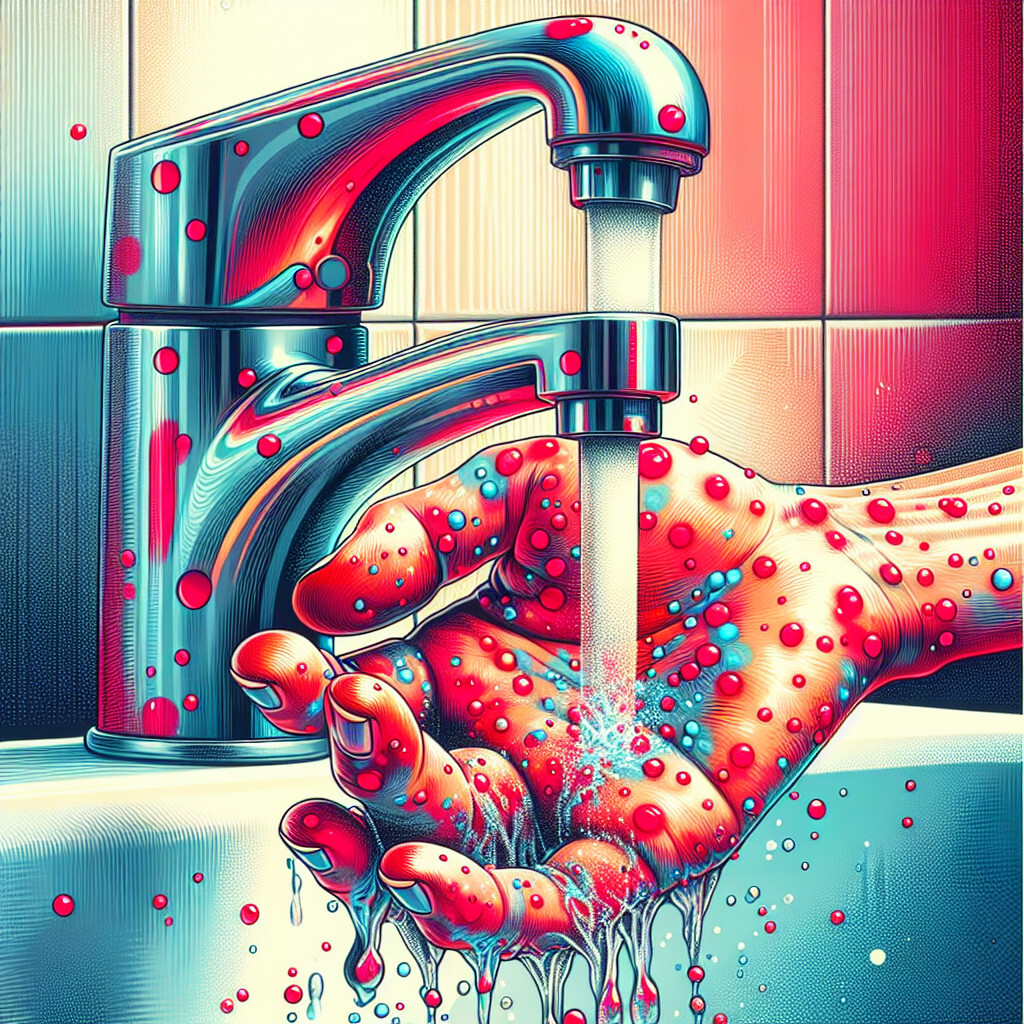-
Table of Contents
“Tap Water Skin Rash: Unseen Irritants, Visible Discomfort.”
Introduction

A tap water skin rash is a type of skin irritation that occurs as a reaction to certain impurities or chemicals present in tap water. This condition, also known as water dermatitis, can manifest as redness, itching, or swelling on the skin after contact with contaminated water. The severity and symptoms can vary from person to person, depending on individual sensitivities and the specific contaminants in the water. Common culprits include chlorine, heavy metals, and certain bacteria or parasites.
Understanding the Connection between Tap Water and Skin Rashes
The human skin, being the largest organ of the body, is often the first line of defense against various environmental factors. One such factor that has been linked to skin rashes is tap water. This article aims to shed light on the connection between tap water and skin rashes, providing a comprehensive understanding of this often overlooked issue.
Tap water, in many parts of the world, is treated with a variety of chemicals to ensure its safety for consumption. However, these chemicals, while effective in eliminating harmful bacteria and viruses, can sometimes have adverse effects on the skin. The most common chemical used in water treatment is chlorine. While chlorine is highly effective in killing bacteria, it can also strip the skin of its natural oils, leading to dryness, itching, and in some cases, rashes.
Moreover, tap water can also contain heavy metals such as lead, copper, and zinc. These metals can accumulate in the body over time and cause a variety of health issues, including skin problems. For instance, exposure to high levels of copper can lead to itchy skin and rashes. Similarly, lead can cause a variety of skin disorders, including changes in skin color and severe itching.
Another factor to consider is the hardness of the water. Hard water contains high levels of minerals such as calcium and magnesium. These minerals can form a film on the skin, preventing it from breathing properly and leading to dryness and irritation. Over time, this can result in a condition known as hard water dermatitis, which is characterized by dry, itchy skin and rashes.
It’s also worth noting that the temperature of the water can play a role in skin health. Hot water can strip the skin of its natural oils more quickly than cold water, leading to dryness and potential rashes. Therefore, it’s recommended to use lukewarm water when bathing or washing your hands to help maintain the skin’s natural moisture balance.
However, it’s important to remember that not everyone who comes into contact with tap water will develop a skin rash. The development of rashes depends on a variety of factors, including the individual’s skin type, the quality of the water, and the duration of exposure. Individuals with sensitive skin or pre-existing skin conditions such as eczema or psoriasis may be more susceptible to developing rashes from tap water.
In conclusion, while tap water is generally safe for consumption, it can sometimes lead to skin rashes due to the presence of chemicals, heavy metals, and hard water minerals. If you suspect that your tap water is causing skin rashes, it may be beneficial to install a water filter or softener to reduce the levels of these substances. Additionally, using lukewarm water and moisturizing regularly can help to maintain the skin’s natural moisture balance and prevent dryness and irritation. As always, if you’re experiencing persistent or severe skin rashes, it’s recommended to seek medical advice to determine the underlying cause and appropriate treatment.
How to Prevent Skin Rashes Caused by Tap Water
Tap water, a seemingly harmless and essential part of our daily lives, can sometimes cause unexpected health issues such as skin rashes. This is often due to the presence of certain chemicals or minerals in the water that can irritate the skin. However, there are several measures that can be taken to prevent skin rashes caused by tap water.
Firstly, it is important to understand the cause of the skin rash. Tap water can contain a variety of substances that may cause skin irritation, including chlorine, heavy metals, and hard water minerals such as calcium and magnesium. These substances can strip the skin of its natural oils, leading to dryness, itching, and in some cases, a rash. If you suspect that your tap water is causing your skin rash, it may be beneficial to have your water tested. This can help identify any potentially harmful substances that may be present.
Once the cause has been identified, there are several steps you can take to mitigate the effects of these substances on your skin. One of the most effective methods is to install a water filter. Water filters can remove a wide range of contaminants from tap water, including chlorine and heavy metals. There are many types of water filters available, ranging from whole-house systems to smaller, faucet-mounted models. Depending on the specific substances present in your tap water, a water treatment professional can recommend the most suitable type of filter for your needs.
In addition to filtering your water, it may also be helpful to adjust your bathing habits. Hot water can exacerbate skin dryness and irritation, so it may be beneficial to use lukewarm water instead. Similarly, spending a long time in the bath or shower can strip the skin of its natural oils, so try to limit your bathing time to 15 minutes or less. After bathing, pat your skin dry gently rather than rubbing it, and apply a moisturizer immediately to lock in moisture.
Using a moisturizer can also help protect your skin from the drying effects of tap water. Look for a moisturizer that is fragrance-free and hypoallergenic to avoid further irritation. It may also be beneficial to choose a moisturizer that contains ingredients known to repair the skin’s barrier, such as ceramides and hyaluronic acid.
If your skin rash persists despite these measures, it may be necessary to seek medical advice. A dermatologist can provide further guidance and may be able to prescribe a topical cream or ointment to help soothe your skin.
In conclusion, while tap water can sometimes cause skin rashes, there are several steps you can take to prevent this. By understanding the cause of your skin rash, installing a water filter, adjusting your bathing habits, and using a suitable moisturizer, you can help protect your skin from the potentially harmful substances in tap water. However, if your skin rash persists, it is important to seek professional medical advice.
The Role of Tap Water Contaminants in Skin Irritations
Tap water, a seemingly innocuous and essential part of our daily lives, can sometimes be a hidden source of skin irritations. The role of tap water contaminants in causing skin rashes is a topic that warrants attention due to the potential health implications. This article aims to shed light on this issue, providing an informative and formal discussion on the subject.
The quality of tap water varies significantly across different regions, depending on the source of the water and the treatment processes it undergoes. While most tap water is treated to remove harmful bacteria and parasites, it often contains various chemicals and minerals. These substances, while generally safe for consumption, can sometimes cause skin irritations in sensitive individuals.
Chlorine is one such chemical commonly found in tap water. It is used extensively in water treatment processes due to its potent disinfectant properties. However, chlorine can also be a skin irritant, causing dryness, itching, and in some cases, rashes. Individuals with pre-existing skin conditions such as eczema or psoriasis may find their symptoms exacerbated by regular exposure to chlorinated water.
Hard water, characterized by high levels of minerals like calcium and magnesium, is another potential culprit. These minerals can disrupt the skin’s natural pH balance, leading to dryness and irritation. Moreover, hard water can react with soap to form a residue that can clog pores and cause acne.
Heavy metals like lead and copper, which can leach into water from old pipes, can also contribute to skin problems. Prolonged exposure to these metals can lead to inflammation and allergic reactions, manifesting as rashes or other skin irritations.
It’s important to note that not everyone will experience skin problems due to tap water contaminants. Individual sensitivity varies widely, and many people can use tap water without any adverse effects. However, for those who do experience skin irritations, it can be a frustrating and uncomfortable problem.
Fortunately, there are several solutions available for those affected. Water filters can be a practical and effective way to reduce the levels of chlorine, heavy metals, and other contaminants in tap water. For those living in areas with hard water, water softeners can help by reducing the mineral content.
In addition, adopting a gentle skincare routine can help mitigate the effects of tap water on the skin. This might include using a mild, pH-balanced cleanser, moisturizing regularly, and avoiding harsh, drying soaps. For those with persistent or severe skin irritations, consulting a dermatologist is advisable.
In conclusion, while tap water is generally safe for use, its contaminants can sometimes cause skin irritations in sensitive individuals. Awareness of this issue is the first step towards finding a solution. By understanding the potential irritants in tap water and taking steps to mitigate their effects, individuals can help protect their skin and maintain its health and vitality.
Treatment Options for Skin Rashes Triggered by Tap Water
Tap water, a seemingly harmless and essential part of our daily lives, can sometimes cause unexpected health issues. One such issue is skin rashes, which can be triggered by various contaminants present in tap water. These rashes can be itchy, painful, and aesthetically displeasing. However, it is important to note that there are several treatment options available for skin rashes caused by tap water.
Firstly, it is crucial to identify the cause of the rash. Tap water can contain a variety of substances that may irritate the skin, including chlorine, heavy metals, and certain bacteria. A dermatologist can perform tests to determine the specific irritant causing the rash. Once the cause is identified, the treatment can be tailored accordingly.
One of the most common treatments for skin rashes is the use of topical creams and ointments. These products contain ingredients like hydrocortisone, which can reduce inflammation and itching. They work by creating a barrier on the skin’s surface, preventing further irritation from the tap water. However, these creams should be used sparingly and under the guidance of a healthcare professional, as prolonged use can lead to skin thinning.
In addition to topical treatments, oral medications may also be prescribed. Antihistamines can help to reduce itching and inflammation, while antibiotics may be necessary if the rash has become infected. It is important to take these medications exactly as prescribed to ensure their effectiveness and to prevent any potential side effects.
For severe cases, a dermatologist may recommend phototherapy. This treatment involves exposing the skin to ultraviolet light under medical supervision. The light can help to reduce inflammation and improve the skin’s overall appearance. However, this treatment is typically reserved for severe cases due to the potential risks associated with prolonged exposure to ultraviolet light.
While these treatments can help to manage the symptoms of a skin rash, it is also important to address the root cause of the problem – the tap water. Installing a water filter can help to remove many of the contaminants that can irritate the skin. There are various types of filters available, including activated carbon filters, reverse osmosis systems, and distillers. Each type has its own advantages and disadvantages, so it is important to research and choose the one that best suits your needs.
In conclusion, while skin rashes triggered by tap water can be uncomfortable and distressing, there are several treatment options available. Topical creams, oral medications, and phototherapy can all help to manage the symptoms. However, it is also important to address the root cause of the problem by installing a water filter. By taking these steps, you can help to ensure that your skin remains healthy and rash-free. Remember, it is always advisable to consult with a healthcare professional before starting any new treatment regimen.
Q&A
1. Question: Can tap water cause skin rash?
Answer: Yes, tap water can cause skin rash if it contains high levels of certain chemicals, minerals, or bacteria.
2. Question: What are the symptoms of a tap water skin rash?
Answer: Symptoms of a tap water skin rash may include redness, itching, swelling, and sometimes blistering or peeling of the skin.
3. Question: How can I treat a skin rash caused by tap water?
Answer: Treatment for a skin rash caused by tap water may include topical creams or ointments to soothe the skin, oral antihistamines to reduce itching, and avoiding contact with the irritant. In severe cases, a doctor may prescribe steroids.
4. Question: How can I prevent a skin rash from tap water?
Answer: To prevent a skin rash from tap water, you can install a water filter to remove harmful substances, limit your exposure to the water, or use skin protective products before coming into contact with the water.
Conclusion
In conclusion, tap water can potentially cause skin rashes due to the presence of certain chemicals, contaminants, or hard water minerals. However, it’s not a common occurrence and varies greatly depending on individual skin sensitivities and the quality of the water. It’s always advisable to seek medical advice if you suspect tap water is causing a skin rash.






